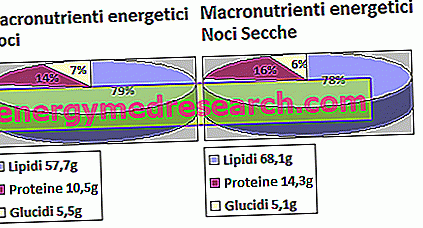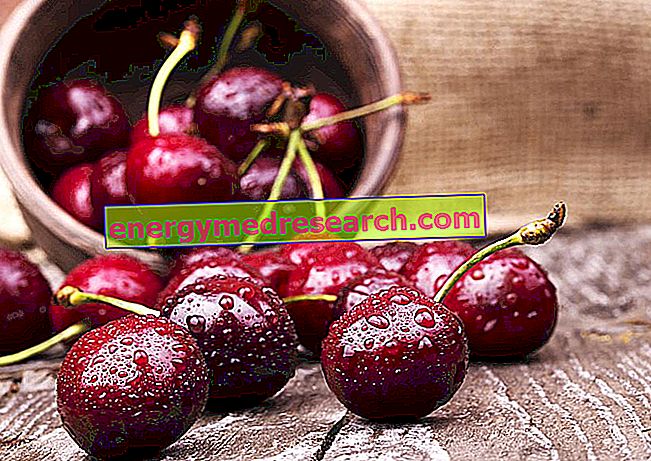Generality
Walnuts are the fruit of the plant "walnut or white walnut". Like pine nuts, almonds, pistachios, etc., walnut is a seed, or rather an achene, belonging to the "dried fruit" group.

Walnuts can be eaten fresh or dried and, on the edible side, an oil rich in "good" fats is made. Contrary to what most people may believe, the fresh and whole fruit of the walnut is fleshy and light green.
The walnut tree is also widely used in the timber industry, the buds are used in gemmotherapy and the bark (in addition to the fleshy portion of the fruit) acts as a natural pigment.
WARNING! In botany, with the term nuts we can indicate various achenes / seeds belonging to Genera and Species totally different from the Juglans regia ; to avoid useless prolixity, below we will describe ONLY the plant and the fruit commonly understood as walnut and walnut.
Description
The walnut tree is widespread and, although it originates from the Middle East (Caucasus, Armenia, Iran, up to the Imalaja mountains), today it is also considered a typical plant of the Italian peninsula.
Walnut prefers hilly and mountainous areas up to 1, 000m altitude. It flowers between April and May, while the fruits ripen between August and September. It reaches and exceeds 12-15m in height; it has a wide, round crown, with broad, unpaired and fragrant leaves. The roots extend first in depth and then in width. The flowers are grouped in thin green bunches, basically whitish or yellowish when hatched.
The walnut fruit, or walnuts, are drupes containing a large seed. Externally, when fresh, they are green in color but brown with ripening and subsequent fall. The epicarp and the fleshy mesocarp constitute the husk, a non-edible portion for the man from which a dark pigment is extracted. The endocarp is hard, woody, also not edible and contains the seed. This, which instead represents the edible portion, can be divided into two symmetrical kernels with a vaguely resembling shape to a human brain; if ripe, they are brownish in color and boast a sweetish, vaguely tannic, crunchy consistency. NB : The kernels of unripe walnuts have a rather unpleasant tannic hint.
Uses of walnut, nuts and suggestions for consumption
As anticipated in the paragraph dedicated to the generalities on walnut and walnuts, both the tree and the fruit are used in different sectors.
It is now known that walnuts are a typical autumn-winter food; they have a very high energy value and nutritional characteristics worthy of note, which we will explain more carefully in the next paragraph. What not everyone knows, however, is that from the edible portion of the seed it is possible to obtain a very valuable oil: walnut oil. This is very rich in polyunsaturated fatty acids, beneficial to the body but poorly conservable and not very resistant to high temperatures. Today, walnut oil has an extremely high retail cost (about € 10 per 100ml, compared to € 1 per 100ml of organic extra virgin olive oil) and, in addition to food consumption, constitutes (together with olive oil) linen and poppy) an extremely fine painting base (oil colors).
The walnut leaves, on the other hand, which are not completely edible, represent an excellent aromatic ingredient. They are often used for the aging of certain cheeses (such as pecorino) and it is not unusual to find them in the garnishes of certain haute cuisine dishes.
Who has never heard of walnut? It is a very widespread material in the timber industry, especially furniture. In addition to the remarkable aesthetic value (brown with dark brown or black streaks), walnut wood has a certain ease of processing since it is not excessively hard.
In the past, the bark of the trunk and the roots of the walnut tree were used as colorants; thanks to the abundant tannic concentration, these raw materials are able to pigment many natural fabrics with brown, therefore their application in the textile field was quite widespread. Today, the same color is mostly extracted from the husk and its uses are varied to say the least.
How not to mention the use of walnut buds in gemmotherapy. These parts of the plant are considered a valid anti-inflammatory and anti-infective against the development of certain bacteria (in particular staffilococcus and streptococcus); their application mainly affects the respiratory system and the skin dermis. In association with other plants, the extract of walnut buds can be used for the treatment of sinusitis, otitis, angine, eczema, acne etc.
Gastronomic and nutritional characteristics of nuts
Walnuts are foods that are particularly suitable for natural consumption. These dried fruits, extracted first from the fleshy shell and then from the shell, consumed fresh or dehydrated, have excellent palatability but do not boast a good satiating power. This is not due to their chemical characteristics, but to the volume of the product. Being highly energetic foods, walnuts should be taken in portions of a few grams a day.
In addition to serving as a snack, walnuts are frequently used: in the formulation of sweets and desserts, to enrich the sauces accompanying the first courses or to cook the dishes, to complement the "salads", etc.
Walnut cake and pureed apples - without butter
X Problems with video playback? Reload from YouTube Go to Video Page Go to Video Recipes Section Watch the video on youtubeThe unripe nuts, traditionally harvested on St. John's Day (June 24th), are used for the production of nocino, a typical liqueur from Modena.
Nocino homemade video recipe
The nutritional characteristics of walnuts are excellent but, as anticipated, since they are highly energetic foods they cannot be consumed in freedom. The high caloric density of walnuts derives mainly from the lipids which, for their part, enjoy an excellent balance between fatty acids. These are mainly unsaturated and the abundance of polyunsaturates (many of which are essential) gives the nuts considerable therapeutic properties. From the latest research it seems that the increase in the consumption of nuts in the population can contribute to raising the share of good fats and antioxidants, consequently reducing both the probability of cardiovascular diseases and tumors. Be careful though! This applies to nuts, as well as to foods that contain the same nutrients. Fresh antioxidants (protective against neoplasms) are also rich in fresh fruit and vegetables; as far as essential fats are concerned (protective from hyperlipemias such as hypercholesterolemia, hypertension, systemic inflammation, etc.), many other seeds (including certain legumes, the germ of cereals, etc.), their respective oils, bring excellent concentrations. and certain fishery products (such as oily fish). Certainly, supplementing with walnuts in a healthy and balanced diet can bring about many health benefits, but it is unlikely that this can happen again in the application to an unbalanced diet.
In addition to the high lipid content, walnuts also contain several grams of protein (with a medium biological value) and a few grams of carbohydrates, mainly simple. The fibers are present in good concentrations.
As far as mineral salts are concerned, the quantities of iron, calcium, phosphorus and potassium are appreciated, while thiamine stands out above all for vitamins.
Nutritional values
Composition for: 100g of Nuts; per 100g of Dried Nuts - Reference values of the INRAN Food Composition Tables
 | |||||
| walnuts | Dried Nuts | ||||
| Edible part | 58.0% | 39.0% | |||
| water | 19.2g | 3.5g | |||
| Protein | 10.5g | 14.3g | |||
| Prevailing amino acids | Glutamic acid, Arginine, Aspartic acid | Glutamic acid, Arginine, Aspartic acid | |||
| Limiting amino acid | Lysine | Lysine | |||
| Lipids TOT | 57.7g | 68.1g | |||
| Saturated fatty acids | -mg | 5.57mg | |||
| Monounsaturated fatty acids | -mg | 9.54mg | |||
| Polyunsaturated fatty acids | -mg | 40.66mg | |||
| Cholesterol | 0.0mg | 0.0mg | |||
| TOT Carbohydrates | 5.5g | 5.1g | |||
| Starch | 1.9g | 1.8g | |||
| Soluble sugars | 3.4g | 3.1g | |||
| Dietary fiber | 3.5g | 6.2g | |||
| Soluble fiber | -g | 0.8g | |||
| Insoluble fiber | -g | 5.4g | |||
| Power | 582.0kcal | 689.0kcal | |||
| Sodium | 3.0mg | 2.0mg | |||
| Potassium | -mg | 368.0mg | |||
| Iron | 2.6mg | 2.1mg | |||
| Football | 131.0mg | 83.0mg | |||
| Phosphorus | 238.0mg | 380.0mg | |||
| Thiamine | 0.58mg | 0.45mg | |||
| Riboflavin | 0.17mg | 0.10mg | |||
| Niacin | 0.80mg | 1.90mg | |||
| Vitamin A | 6.0 µg | 8.0 µg | |||
| C vitamin | tr | tr | |||
| Vitamin E | -mg | 3.0mg | |||



